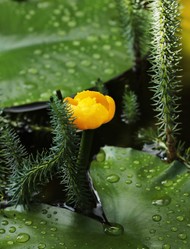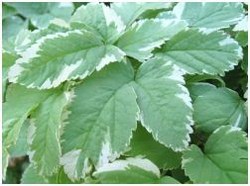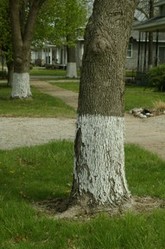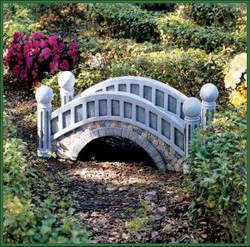I have a simply made and quite small pond on my allotment. It is not deep, it cannot be, for I dug it in the fruit tree section of my plot and tree roots got in the way of my digging too far down. I constructed it out of a tarpaulin, a hole and obviously water, along with a dollop of frogspawn that I managed to acquire one Spring some years ago, and I have had frogs every year since then. The frogs, which occasionally surprise visitors by leaping out, serve an important function of eating slugs that would otherwise attack my crops. But you hardly see the frogs, for they hunt in the compost heap, the cabbage beds and the greenhouses during the day. However,they delighted my three year old grand-daughter when she visited and saw a large, fat frog. I do think, though, that once we were visited by a heron that was too heavy for the tree branch on which it perched as it searched for frogs, and consequently broke it.
The hole can be simple, but it can also be of differing depths to cater for a variety of plants, but it must be watertight. In the past farmers digging dew ponds used to use puddled clay, which is clay that has been soaked and beaten into a paste that is smeared around the base and sides of the pond and allowed to set solid. It's watertight, but messy. You can use concrete, but the simple and effective way is to use a pond liner.
First ensure that the hole has no sharp stones that can puncture the liner. Doing this involves clearing bottom and sides of any debris, however small. Some pond makers add a layer of fine [not gritty] sand, but this does not protect the sides. Then begin with a piece of pond underlay. To determine the area needed work out the total area of pond and sides and double it. This is the area of underlay that you need. It will extend over the sides. Smooth it out and press it down into the corners of the pond. Then take exactly the same sized piece of butyl pond liner, laying it down to cover the underlay. The exposed area of liner is then covered with soil or gravel to landscape the feature. Soil is preferable as it allows pondside plants to grow, and this creates a more natural pond. You can then fill up your pond.
Here is an essential word of warning. If you are installing an electrical pump, get it installed by a properly qualified electrician. Electricity and water are a dangerous combination.
Another word of warning. Children. Ponds are dangerous for young children, as it is possible to drown in an inch or less of water. I put a safety grill over part of my pond, allowing enough space for the frogs to come and go. When children visit the pond they are always supervised.













 Women of the Gospelson 10/11/2025
Women of the Gospelson 10/11/2025
 Religious Gardenson 08/25/2025
Religious Gardenson 08/25/2025
 Doctor of the Church: John Henry Newmanon 08/03/2025
Doctor of the Church: John Henry Newmanon 08/03/2025
 Restoring the Palm Houseon 07/16/2025
Restoring the Palm Houseon 07/16/2025




Comments
Irises, reeds, marsh plants,cranberry, other bog, plants such as cotton grass and sphagnum moss.
Thank you for your answer Oct. 4, 2018, to my previous question Oct. 3, 2018.
What plants might you select were you to plan a rain garden for private- or public-place users?
A small pond was better than no pond.
One precaution in my area is that if you have a fish pond, beware of herons, which are common round here. We are close the following waterways: the Bridgewater Canal, the Manchester Ship Canal and the River Mersey. There was much scope for herons, so they went for the fish, fed, bred and spread. Soon they began to raid ornamental fish ponds in gardens. Valuable ornamental carp disappeared down their gullets.
Every person should try to incorporate nature into their environment, even if they don't have much room like you. Even people in apartments can grow plants to attract butterflies or feed birds. Thanks for this article. Not everyone thinks of making a pond on such a small scale.
I am delighted with your response.
I really enjoyed this, and learned quite a few important things.
Rain gardens are a good idea that enables gardeners to make the most of urban spaces.
Parrot's feather and water hyacinth are banned from sale in the UK. Water lettuce is still legal, as the cooler climate of Britain acts as a natural brake on the spread of the plant
FrankBeswick, Thank you for the practicalities and products. The tips all are welcome, especially the helpful reminder about the waterer with a rose.
What do you think of rain gardens?
I have all four of the books that you include and find them correct, inspiring and pretty.
Is invasive status not in effect regarding parrot feather, water hyacinth and water lettuce on your side of the pond?
What you said about clean water was essential and very relevant. Where I live refreshment of ponds by rain works for much of the year, but not in Summer. As you originated in Britain, so I recall, you will know that my area[South Lancashire], is prone to rain.
But what you said about wildlife other than birds coming to the birdbath strikes a chord with me, because I have just realized that as mine is the only pond on the allotment site the foxes must come to it to drink. This tells me that I need to pay attention to the water levels to a greater degree than I thought. I don't like the idea of an animal going thirsty.
My sister has a pond, and I believe there are frogs that enjoy it. We only have a birdbath, quite large made from a rock with added concrete. It is enjoyed by more wildlife than just birds, and our cats! But mosquitoes can be a problem if we don't keep refilling it with clean water.